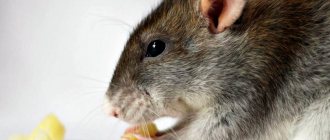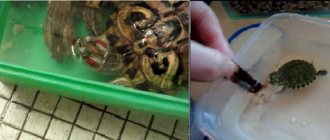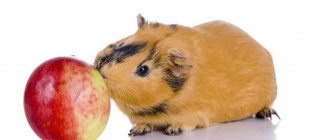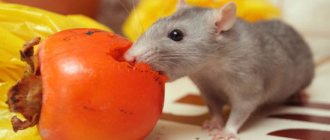Healthy digestion is the basis of longevity for these animals, so attention should be paid not only to the composition of the diet, but also to the organization of the feeding regime. Hamsters are nocturnal and sleep almost all the time during the day. This feature must be taken into account to decide how many times you can feed your hamster.
What does a rodent eat in nature?
Being an omnivore, the hamster eats almost everything that comes into contact with it. The exact diet is determined by the habitat. If a rodent lives in a steppe or semi-desert, it feeds on protein foods, including:
- Insects.
- Snails.
- Zhukov.
- Worms.
The importance of protein feed increases after hibernation or during gestation.
Field and garden individuals eat greens, fruits, cereals and vegetables. Feeding domestic pets should completely replicate the diet of their wild counterparts.
The natural instinct of hamsters is to be thrifty. Therefore, closer to the winter season, they fill up their storage. In this case, the pantry must be located in a hidden place and inaccessible to other animals. When keeping a rodent at home, you will need to periodically remove supplies, since food quickly spoils and emits an unpleasant odor.
Pros and cons of content
Pros of keeping a hamster
- low cost of a hamster;
- low cost of accessories for maintenance;
- takes up little space;
- does not require special care and knowledge;
- does not make noise;
- no wool;
- no need for daily walks;
- you can keep one hamster, without a pair;
- does not pose a danger to both adults and children;
- easy to breed;
- easy to place the babies.
Disadvantages of keeping a hamster
- they sleep during the day and are active at night;
- unpleasant odor if you do not clean up food debris and excrement daily;
- low life expectancy, from 2 to 3 years;
- some individuals hibernate, depending on the species and conditions of detention.
Rules for feeding at home
In the wild, the daily menu of hamsters is determined by their habitat. To ensure that your pet does not experience a shortage of essential food in captivity, you need to carefully think through the diet and maintain a balanced level of macro- and microelements in the animal’s body.
Mode
Veterinarians recommend feeding your hamster 2 times a day - morning and evening. It is better to give fresh food first so that the rodent does not start hiding it in the pantry. The bulk of the food is served in the evening. Hamsters are crepuscular rodents that prefer a nocturnal lifestyle.
To prevent your pet from overeating or experiencing food shortages, you need to adhere to the established feeding regimen.
Quantity
Depending on the age and size of the pet, different amounts of food are required. The hamster consumes quite a lot of food, and the daily norm is 80-100% of body weight. Appetite is determined by breed characteristics, microclimate and individual preferences of the individual.
The hamster considers food not only as part of the daily menu, but also as a strategic reserve. Therefore, uneaten food is put aside by the rodent in case of starvation. This leads to the appearance of an unpleasant odor and the development of pathogenic organisms in spoiled products. To prevent such troubles, you should remove the remains in a timely manner. Instead, you can put a few seeds in your pet's storage.
Nutrition for elderly and sick hamsters
Animals that are sick or are already quite old (elderly) are characterized by a decrease in their activity and appetite. Therefore, the owner needs to rebuild the animal’s diet and feeding regime.
- Food should be predominantly chopped and grated. also give porridge with water or pureed vegetables without salt and sugar with added vitamins.
- To prevent intestinal disorders, your pet must be given grain food.
ATTENTION. The animal should be provided with plenty of fluids to prevent dehydration. As a drink, you can prepare a chamomile decoction or regular drinking water, but exclude honey and milk
Features of special food for hamsters
Ready-made food for rodents is available in pet stores, which have a balanced composition of vitamins and microelements.
Dry
Feeding domestic hamsters should include dry mixtures, which make up the bulk of their diet. Such food is produced using special technologies, taking into account the preferences and needs of the animal. Carefully selected ingredients of natural origin are added to the complexes.
Dry food mixture is the main element in a hamster's diet.
You can also find dry food for sale for other rodents or birds. However, it is not recommended to use them for hamsters, because... they have the wrong composition.
Wet
Despite the use of dry mixtures, natural wet food should not be removed from the hamsters' diet. The following vegetables are allowed to be used for feeding:
- Zucchini.
- Carrot.
- Lettuce leaves.
- Pumpkin, etc.
However, it is better to avoid using watermelons, cabbage, and potatoes, because... they can lead to digestive disorders in hamsters.
It is allowed to add some fruits to the menu. Apples, grapes and currants are especially beneficial for rodents.
Animals like raisins and dried apricots. You can give your pet apricots, pears or bananas as a treat. However, the fruits of the citrus family are contraindicated for hamsters. You should also not feed kiwis and avocados to rodents.
The hamster's diet includes dried apricots and raisins.
What can hamsters eat and what can’t hamsters eat?
It is important to have an idea of what you can feed hamsters, what fruits, vegetables or other types of foods can be given, and which are strictly prohibited or undesirable for your furry pet. Many owners give cabbage to their rodent, but only a few know that cabbage is harmful to the hamster’s digestion.
In addition to cereal mixtures and special foods, it is advisable to treat your pet with cereals, fruits, nuts, berries and dried fruits. Hamsters' food must contain a range of nutrients and vitamins. They provide essential vitamins and other beneficial substances.
What to feed hamsters:
- Carrots, broccoli, banana, cherries, currants (black/red), gooseberries, leeks, parsley, dill. These food sets contain vitamin A, which promotes the growth of new cells and has a positive effect on bones, fur and vision.
- Sunflower seeds, oatmeal, oats, peas, buckwheat, wheat, cashews, walnuts. Vitamin B affects the efficiency of digestion and has a good effect on the nervous system.
- Banana, apple, cherry, gooseberry, currant, blueberry, rose hip, radish, parsley, dill, dandelion leaves. These products contain vitamin C, which strengthens the immune system, promotes bone growth and cell repair.
- Sunflower seeds, cashews, wheat, barley, wheat and oatmeal, oats, walnuts, dill, dandelion leaves. These substances contain vitamin E. It is necessary for good blood circulation and muscle function.
List of recommended foods
Hamsters have a weak stomach, so you can feed them only those foods that they can chew and digest. It is forbidden to give the animal food from the table, spices, hot and sour foods.
Vegetables
You need to include fresh vegetables in your hamster's daily menu. It is necessary even when using ready-made feed. The following products are allowed:
- Zucchini.
- Cucumbers.
- Tomatoes.
- Beet.
- Broccoli.
- Eggplant.
- Bell pepper.
At the same time, you cannot feed the rodent potatoes, white cabbage and canned vegetables.
Fruits
There are several rules to consider when choosing fruit for hamsters:
- Animals are allowed only seasonal fruits grown nearby.
- The fruits must be ripe, but not rotten.
- You can use sour fruits.
- The frequency of taking fruits should not exceed 1-2 times a week.
- It is better to avoid using exotic fruits.
In addition, you should not feed hamsters fruits with seeds.
It is forbidden to give hamsters fruits containing seeds.
Berries
Pets are given fresh and frozen berries. Among them:
- Strawberry.
- Strawberries.
- Gooseberry.
- Cherry.
- Cherries.
- Blueberry.
- Currant.
If the berries contain large seeds, they must be removed before serving to the hamster. The seeds contain hydrocyanic acid, which can negatively affect the health of animals.
Greenery
For greens, pets are given nettles, clover leaves and plantain. If you have a garden area, you can pick lettuce leaves or dill. In winter, many hamster owners germinate cereal grains in the apartment and give sprouts to rodents.
Cereals
Various cereals are beneficial for hamsters. Among them:
- Oats.
- Buckwheat.
- Wheat.
Your hamster's diet should include whole grain cereals.
The main thing is that food for rodents is fresh and natural.
Nuts
Nuts contain a lot of fat. Therefore, they are given to the hamster in limited quantities and rarely (2-3 pieces per day). The pet can be periodically fed hazelnuts, peanuts, walnuts and pine nuts. In addition, he is allowed sunflower, melon and pumpkin seeds.
Dried fruits
Dried fruits are used as treats for hamsters. Allowed products include raisins, prunes and dried apricots.
Milk
Rodents are allowed dairy products. The main thing is that they have a low fat content.
Protein food
In their natural habitat, hamsters eat beetles, insects, worms and snails as protein food. At home, they can be replaced by boiled chicken, eggs, lean fish, mealworms and shrimp.
Pasta and bakery products
Hamsters love boiled pasta. However, they are given as a treat, no more than once a week. Occasionally you can feed your pet stale bread.
Rodents are allowed to give boiled pasta.
What products are allowed and not allowed?
You can find out your hamster's preferences experimentally, but it is important to make the diet as balanced as possible. They are based on grains, cereals and legumes, these can be:
- peas (except canned);
- barley;
- cracked wheat;
- oats;
- lentils.
It is better to exclude corn from the diet due to its high sugar content.
From seeds you can give:
- fresh sunflower seeds (slightly dried, but unsalted);
- melons and watermelon must first be washed and dried;
- pumpkin and squash can be included as an anthelmintic;
- flaxseed and sesame seeds stabilize the gastrointestinal tract, preventing constipation, and they will also make the coat shiny and soft.
Sesame seeds are quite fatty, so they are included in the diet only as a medicine.
Seeds of apples, apricots, peaches, plums, cherries and sour cherries are prohibited.
Nuts are another important component in the diet. However, they should not be overused due to their high fat content. Prohibited:
- almond;
- Brazilian nut;
- acorns.
It is important for the owner to remember that dry pasta, white or rye bread, muesli and ready-made breakfasts should not be given. It is permissible to offer boiled rice only in case of diarrhea.
As a protein component, you can offer low-fat cottage cheese, boiled chicken or eggs, lean fish, dry or fresh insects, which are sold in a pet store.
Be sure to include succulent food: boiled or fresh vegetables and fruits. It is important to take into account that it is strictly forbidden to give exotic and citrus fruits, persimmons and watermelon. Among the prohibited vegetables are: red cabbage, onions, garlic. Potatoes are not recommended due to their high starch content, but sometimes they can be given boiled or raw. In this case, the product must be ripe, young, without pesticides and nitrates. You can offer seasonal sweet berries rich in vitamins; in winter you can replace them with homemade dried fruits.
Hamsters love fresh greens. You can give them lettuce, dandelion leaves, parsley, dill, clover and some types of cabbage, but spicy herbs, wild garlic and sorrel are strictly prohibited.
Branches of fruit and deciduous trees are necessary for sharpening teeth, and coniferous trees are prohibited.
Fresh and clean water is important for hamsters, just as it is for humans. Due to the predominance of “dry” nutrition, it is important to ensure constant access to drink.
Apples in the diet of hamsters
Rodents eat apples with particular pleasure. However, such fruits can be given to them strictly according to the instructions. You cannot limit your diet to an apple diet, since the fruits are used as an additional source of vitamins.
Benefits for the body
The key advantage of apples is the high concentration of microelements in their composition. However, one must also take into account the presence of malic acid, which is unsafe for the animal’s gastrointestinal tract.
The fruits saturate the pet’s body with glucose in an acceptable amount.
Apples contain fiber, which improves the digestive system and prevents tumors in rodents.
Variety selection criteria
When choosing a variety of apples, you need to take into account that some hamsters prefer sour fruits, others prefer sweet ones.
At the same time, it is not recommended to give apples with a high concentration of sugars to young animals. This is associated with a risk of developing diabetes. Excessively sour fruits are unsafe for the gastrointestinal tract. Therefore, it is better to find a middle ground using sweet and sour fruits. It is recommended to choose apples grown in the region where the owner lives.
When selecting fruits, you need to make sure that they meet a number of criteria:
- Reached ripeness.
- Grown in a local garden.
- Rinse thoroughly under running water.
It is recommended to give hamsters apples of sweet and sour varieties.
Processing Tips
Before serving to your pet, the fruit must be immersed in water for several hours. If a sweet and sour variety contains a lot of sugar, it can become dangerous for the rodent, especially for its gastrointestinal tract.
The seeds must be removed to avoid poisoning. It is better to remove the peel if the apples were purchased at the store. It is enough to wash the fruits grown in your garden.
Introducing fruits into the diet
You need to introduce apples to your hamsters' menu gradually, sticking to small portions. At the same time, it is important to carefully monitor the general well-being of rodents. If their body reacts positively to the new product, the daily intake can be increased. However, the fruits should not be allowed to rot in the cage area. It is better to give apples to the animal up to 3 times a week.
Features of feeding a pregnant or lactating woman
During pregnancy and lactation, the female needs additional nutrition; on average, 10 hamsters are born. It takes a lot of effort and energy to feed them, so the usual portion is increased by 1.5 times. There is also an urgent need for protein, which plays a significant role for active growth and development. 2-3 times a week, boiled chicken meat or egg yolk, lean fish are prepared for her, which are given alternately. Low-fat natural cottage cheese is given less often than other products, but it cannot be completely excluded - it is necessary for the formation of the fetal skeleton. For convenience, you can select special days, for example: Tuesday, Thursday and Saturday.
Juice-containing products are given daily, with preference given to carrots, zucchini and pumpkin. It is better to avoid apples during pregnancy and breastfeeding, as they can cause fermentation in the intestines. To actively produce milk, you need to drink plenty of fluids.
How to feed a small hamster
If the pregnancy proceeded calmly, then there is a high probability that in the first weeks the female will independently feed her children, and then she will grind dry food and accustom her to adult food.
The owner must not touch them under any circumstances. Having smelled someone else's scent, she may refuse them, not recognize them as her own, and eat them. If the female does not strive to feed the hamsters with milk, then they are taken into a separate warm hole, and for feeding you can buy a specialized milk formula for kittens at a pet store. Feeding is done from a pipette or using a paint brush dipped in milk.
Upon reaching 2 weeks of age, children's complementary foods include dairy-free oat or buckwheat porridge, low-fat cottage cheese, and an egg. It is also acceptable to give baby meat puree, namely turkey or chicken. At 3 weeks, an adult grain mixture is introduced, having previously ground it. At 6 weeks, nutrition becomes like that of an adult.
Various goodies
Grocery stores offer a variety of treats for hamsters. But before purchasing such food, you should make sure that there is no salt, sugar, flavor enhancers or flavorings in their composition. Such additives are a slow poison for rodents. Therefore, it is better to give preference to the following foods:
- Nuts.
- Banana chips.
- Dried fruits and dried vegetables.
- Sunflower seeds.
Sunflower seeds are a treat for your pet hamster.
Tree branches and grass
Solid food is a must for a furry pet. A rodent's teeth continue to grow throughout its life, so when it eats tree shoots, it wears down its fangs.
Before submitting, the branches need to be properly prepared. Raw materials are collected away from roads, for example in the forest or in the country. Then it is thoroughly washed and scalded with boiling water to eliminate pathogens.
It is allowed to feed the hamster with branches of pear, maple, birch and apple trees.
Vitamins for pets
Store-bought mixtures for hamsters contain all the necessary vitamins and microelements. However, in some cases it is necessary to introduce them artificially in order to protect pets from the development of infectious or viral diseases.
Vitamins for hamsters are an important component in their diet.
Vitamin complexes with different compositions are available for sale. However, you cannot choose them yourself without first consulting a veterinarian. The specialist will advise the appropriate complementary foods and dosage based on the age and condition of the pet’s body.
What can you feed hamsters?
A safe feeding choice is balanced grain foods formulated specifically for rodents. They contain vitamins and hamster favorite treats like oats, wheat, corn and peas, as well as pumpkin seeds and nuts. This is the kind of food that should be included in the main diet of Djungarian hamsters and other types of rodents.
Sunflower seeds are often added to food, but the less of them in the composition, the better for the animal. Despite the pleasant taste that hamsters love, food for them turns out to be too fatty. Replace the seeds with pieces of walnuts, hazelnuts or peanuts. Don't forget to clean the shell, as your hamster can easily damage his teeth trying to chew it on his own. Do not offer your pet almonds, apricot or cherry pits; they are toxic to the hamster's body.
When choosing food in the store, give preference to special mixtures designed for rodents, including Djungarian hamsters. Pay attention to the composition: it must be suitable for your pet’s age. When you want to please your hamster with a delicious treat, offer him an unusual food on a stick, which is covered with tasty grains. In this case, the pet will be able to grind its teeth and at the same time be an independent food provider. Cereal sticks can be served once a month. By the way, similar recommendations will be made for various crackers and biscuits for hamsters.
Animals eat bread with pleasure, but it is advisable to offer them whole grain varieties. You can feed with bread only in the autumn-winter period and in small portions. Be sure to observe the rodent's stool and, if signs of constipation appear, it is better to refuse bread. There should always be grain food in the feeder so that the hamster does not feel like there is a lack of food. Otherwise, he is inclined to save, begins to stockpile and ends up with banal malnutrition.
Forbidden food
When feeding hamsters at home, you should avoid the following foods:
- Syrov.
- Cabbages.
- Of bread.
- Fruits of exotic origin and citrus fruits.
- Sausage products.
- Sweet food.
It is better to avoid feeding your rodent dandelions. Their stems and foliage contain milky sap, which provokes irritation of the animal’s pouches.
Hot, spicy and fatty foods should not be allowed in the diet.
Choosing a location for the cage
Often owners do not pay attention to where to place the hamster's cage. This is a rather important point, which affects both the health and life expectancy of the animal.
Things to consider when choosing a location for a cage:
- Avoid direct sunlight on the cage;
- avoid bright light;
- limit access to the cage for other animals;
- avoid drafts;
- there should be no temperature changes in the room;
- do not place under air conditioning;
- do not place near heating devices;
- there should be no strong odors or smoke in the room;
- do not place near a TV, radio, or stereo system;
- do not place the cage in a walk-through area;
- Do not place it in a children's playroom, as hamsters are afraid of sharp and loud sounds.
For the cage you need to choose a quiet, non-passable place. The cage should not be moved frequently. The optimal temperature for keeping hamsters is 20-25 degrees.
It is necessary to install a house in the cage so that the hamster can rest during the daytime and feel safe. Also in the cage you need to put 2 feeders and a drinking bowl. Feeders with drinking bowls must be attached to the bars of the cage, otherwise an active animal will definitely turn over and trample the contents. One feeder is needed for the grain mixture, which is the main feed, the other is needed for succulent feed.
It is worth considering that hamsters are very mobile and active animals. They definitely need to buy and install a treadmill, ball, tunnels, and labyrinths in the cage. Special playgrounds for hamsters are sold, which already include the listed attractions, as well as various toys for the hamster.
Some nuances of feeding
You need to care for hamsters strictly according to the recommendations of specialists. When planning a diet, it is necessary to take into account age, current health status and physiological processes such as hibernation or gestation.
Newborn hamsters
In most cases, the female feeds the children on her own if she is provided with the right conditions. Therefore, there is no need to disrupt the natural cycle. If the female runs away, leaving her offspring orphaned, she has to feed them special food. For the first few days after birth, newborn hamsters are given kitten formula. Pets need to be fed every 2 hours using a pipette.
You can feed the offspring of domestic hamsters yourself using kitten formula.
Individuals aged 2 weeks are given infant formula “Gerber” and “Agusha”, cereals without milk and sugar, and also greens grown at home.
3-week-old animals are offered crushed adult food.
Elderly
As a rodent ages, its teeth begin to deteriorate, so it stops eating as before. Against the background of age-related changes, pureed vegetables and chopped feed should be included in the diet. You can give your rodent baby cereals that do not contain milk. And to avoid problems with the gastrointestinal tract, your pet should be periodically fed grain porridge.
Pregnant or nursing
During pregnancy or nursing the offspring, the female needs to be given a lot of protein food. This includes boiled fish, chicken, eggs, shrimp and mealworms.
Sick and weak
If your pet is sick, he will have to be fed using a syringe without a needle. In most cases, warm chamomile is brewed for such rodents. The use of honey or milk is prohibited. If the hamster refuses to eat food, you will have to forcefully give it, otherwise the pet will not recover.
Nutrition for small hamsters
In cases where a hamster gives birth to babies or very small hamsters were purchased, the owner has the question of how and what to feed such babies.
If hamsters live with their mother, then she feeds them for up to 1-1.5 months. However, if the female refuses to feed the babies or for some reason cannot do so, then the owner will have to feed the hamsters.
- First week. Newborns are fed regular infant formula via a syringe (without a needle) or dropper every three hours a day and twice at night.
- Second or third weeks. Hamsters can gradually add finely grated vegetables, fruits and food, as well as boiled porridge . In this case, you should gradually reduce the amount of infant formula.
- Fourth week. From this point on, small rodents are already able to feed on their own without any restrictions in the diet, so you can finish feeding with infant formula .
Have you ever had to supplement feeding newborn rodents?











